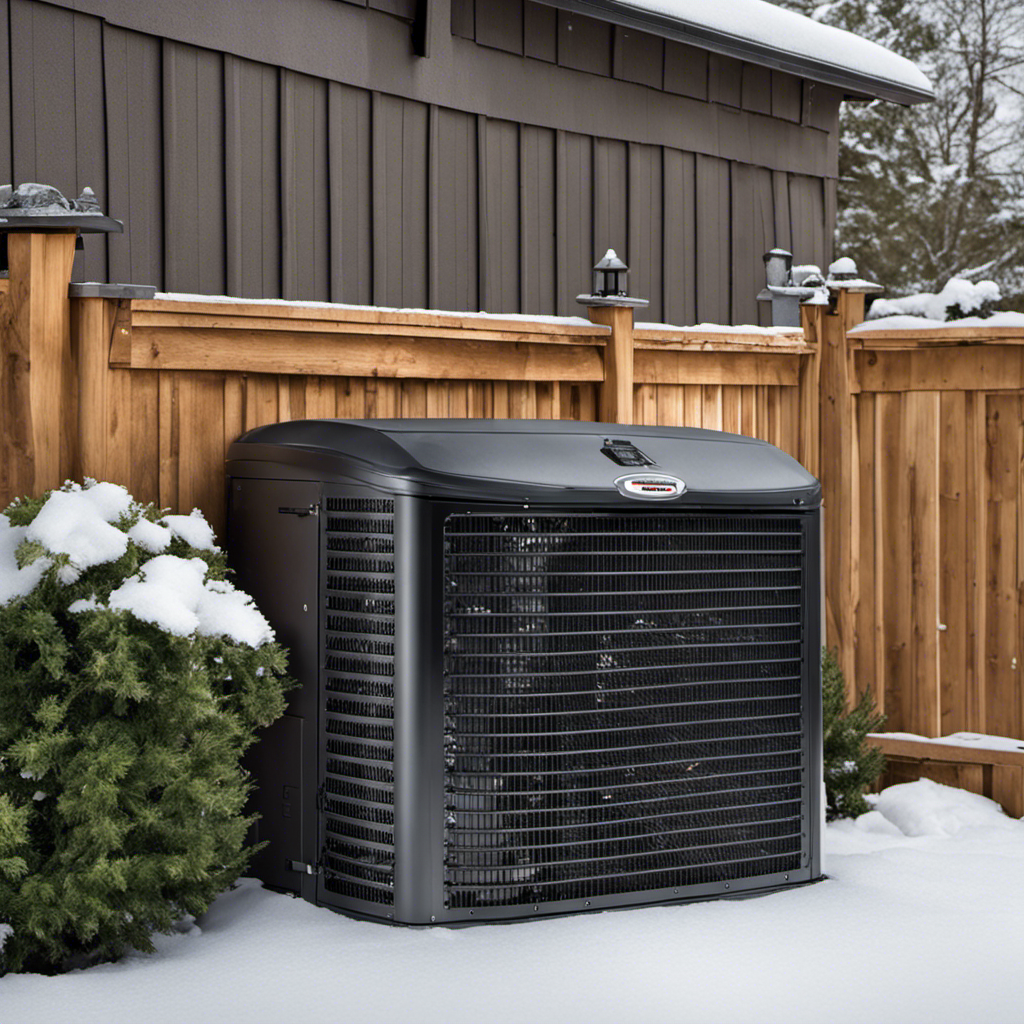In order to ensure the longevity and optimal performance of your outside AC unit, it is crucial to take proactive measures to protect it from various external factors.
This article aims to provide you with practical tips and guidelines on weatherproofing, debris clearance, protective cover installation, pest prevention, and regular maintenance.
By following these recommendations, you can safeguard your AC unit, thereby serving yourself and promoting its efficient service to others.
Key Takeaways
- Properly cover the unit during winter months to protect it from harsh elements
- Regularly remove debris around the unit to ensure proper airflow
- Choose a durable and weather-resistant cover that fits the unit properly
- Keep the area around the unit clean and free from debris to prevent pests from entering
Weatherproofing Your AC Unit
One important step in weatherproofing your AC unit is to ensure that it is properly covered during the winter months. This is crucial in protecting the unit from the harsh elements and preventing potential damage.
One aspect of weatherproofing involves insulating pipes to prevent them from freezing and bursting. Insulating pipes helps to maintain the temperature and prevent heat loss, ensuring that the AC unit functions optimally.
Additionally, it is important to seal any gaps or openings around the unit to prevent cold air from entering and warm air from escaping. This can be done using weatherstripping or caulking.
Clearing Debris Around the Unit
To effectively maintain and protect your outside AC unit, there are several key steps you should take.
First, regularly remove any debris and clear the area around the unit. Debris such as leaves, grass clippings, and branches can accumulate around the unit, obstructing the airflow and reducing its efficiency. This can lead to increased energy consumption and potential damage to the unit. By clearing the area, you ensure proper airflow and reduce the risk of overheating.
Secondly, it is important to clean the coils of your AC unit. Over time, dirt and debris can accumulate on the coils, inhibiting their ability to transfer heat effectively. Cleaning the coils regularly will help improve the unit’s efficiency and extend its lifespan.
Lastly, while clearing the debris and cleaning the coils, it is also essential to check for any visible damage, such as bent fins or leaks. Addressing these issues promptly will prevent further damage and ensure optimal performance of your AC unit.
Installing a Protective Cover
When considering how to protect your outside AC unit, it is important to explore the option of installing a protective cover. Choosing the right cover is crucial to ensure maximum protection for your unit. Look for covers made of durable and weather-resistant materials that can withstand harsh outdoor conditions. It is essential to select a cover that fits your AC unit properly, ensuring that it covers the entire unit without any gaps.
However, it is important to be aware of the potential risks of covering the unit. A cover that is not breathable or properly ventilated can trap moisture inside, leading to the growth of mold and mildew. Additionally, covering the unit improperly can restrict airflow, affecting the unit’s performance. Therefore, it is important to follow the manufacturer’s instructions and guidelines when installing a protective cover.
Securing Against Pests and Critters
In order to safeguard your outside AC unit, it is imperative to take measures for securing against pests and critters, such as rodents and insects, that can potentially cause damage to the unit’s components. Implementing pest control methods and rodent proofing techniques can help prevent these unwanted visitors from wreaking havoc on your AC system.
To control pests, it is recommended to keep the surrounding area clean and free from debris, as clutter provides hiding places for insects and rodents. Additionally, sealing any gaps or cracks around the unit with caulk or weather stripping can help keep pests out. Installing wire mesh covers over vents and openings can also deter critters from gaining access to the unit.
Regular inspection and maintenance are crucial to ensure the effectiveness of these measures in protecting your outside AC unit.
Regular Maintenance and Inspections
During the lifespan of your outside AC unit, regular maintenance and inspections are essential to ensure optimal performance and longevity. Implementing preventive measures and scheduling professional servicing will help keep your unit in top shape.
Regular maintenance involves cleaning or replacing air filters every few months to maintain proper airflow and prevent dust and debris buildup. Additionally, inspecting the unit’s coils, fins, and condensate drain regularly can help identify and address any issues promptly.
Professional servicing should be done annually to ensure that all components are functioning correctly and efficiently. A qualified technician will conduct a thorough inspection, clean the unit, and make any necessary repairs or adjustments.
Frequently Asked Questions
Is It Necessary to Weatherproof My AC Unit if It Already Has a Protective Cover Installed?
Weatherproofing your AC unit is necessary, even if it already has a protective cover installed. While the cover provides some protection, weatherproofing ensures maximum effectiveness in shielding the unit from harsh weather conditions and potential damage.
Can I Use a Regular Tarp or Plastic Sheet to Cover My AC Unit Instead of Purchasing a Specific Protective Cover?
Using a tarp as a protective cover for an AC unit may provide temporary protection, but it is not recommended for long-term use. It is important to invest in a specific protective cover to ensure proper insulation and prevent damage. Additionally, regular pest inspections are necessary to maintain the unit’s efficiency.
How Often Should I Inspect My AC Unit for Pests and Critters?
Inspecting your AC unit for pests and critters is crucial to ensure its proper functioning. Regular inspections should be conducted at least once a month to detect any signs of infestation. Implement preventive measures such as sealing openings and using pest repellents to minimize risks.
What Are Some Common Signs of Pest or Critter Infestation in an AC Unit?
Signs of pest or critter infestation in an AC unit include unusual noises, foul odors, reduced airflow, and visible droppings. Prevention measures such as regular inspections, sealing entry points, and keeping the surroundings clean can help protect the unit.
Are There Any Specific Maintenance Tasks That I Should Perform During the Winter Months When My AC Unit Is Not in Use?
During winter months, it is important to perform certain maintenance tasks for outside AC units. This includes cleaning debris, covering the unit, and ensuring proper insulation. Additionally, scheduling professional inspections can provide numerous benefits such as early detection of any potential issues.


